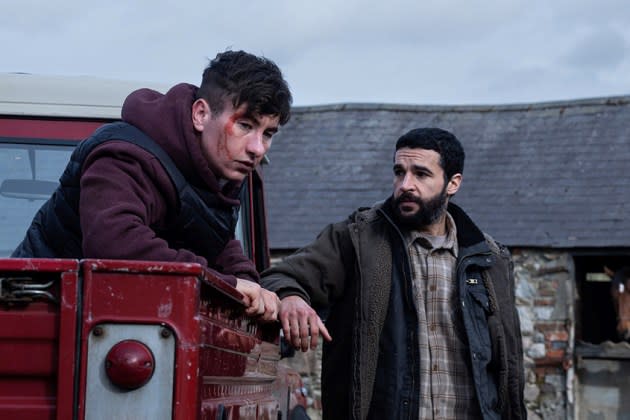What do you do when your lead actor, the Oscar-nominated Paul Mescal, has to drop out? For director Christopher Andrews, the answer was simple: bring in another rising star, Barry Keoghan. Andrews’ gritty revenge thriller, Bring Them Down, premiering at the Toronto International Film Festival on September 8, didn’t miss a beat with the switch, securing Keoghan, hot off his BAFTA win for The Banshees of Inisherin.
But Keoghan wasn’t the only change Andrews embraced for his feature debut. Originally intended to be set in the U.K., the film, which revolves around two rival sheep-farming families, shifted its setting to the rugged landscapes of Ireland’s Connemara. This move not only added authenticity but also took advantage of the country’s attractive tax credits.
Speaking with Variety, Andrews shared his thoughts on working with Keoghan, navigating unexpected changes, and the art of creating convincing on-screen sheep carnage.
From England to Ireland: A Story Reborn
Originally envisioned as a U.K.-set drama, Bring Them Down underwent a location change to Ireland to maximize production benefits, especially the country’s tax incentives. For Andrews, authenticity was non-negotiable, even with the move across the Irish Sea.
“We didn’t just want to plop the story into Ireland without it feeling true to the land and the people,” Andrews said. “When we spoke to local farmers, they confirmed that the experiences were similar. The farming methods in Northern England and rural Ireland share roots that go back centuries.”
Reworking the script to reflect the Irish landscape and dialects took time, but Andrews felt it was essential to ground the story in its new setting. The film’s dialogue, much of it in Irish, plays a crucial role in deepening that sense of place.
The Casting Shuffle: Trading Mescal for Keoghan
Initially, Bring Them Down boasted a star-studded pairing of Paul Mescal and Tom Burke. But as happens in the world of filmmaking, schedules conflicted—Burke joined Mad Max: Fury Road, while Mescal’s growing slate meant he had to step back. While losing Mescal could have been a major blow, Andrews took it in stride.
“Would it have been an amazing film with Paul and Tom? Absolutely. But then we got Barry and Christopher [Abbott], which was incredible,” Andrews explained. “You can’t always control everything in casting, especially with tight budgets, but sometimes you strike gold, and we did.”
Keoghan came on board before The Banshees of Inisherin hit its peak, but by the time Bring Them Down started shooting, Keoghan was a BAFTA winner and Oscar nominee. Andrews chuckled about how perfectly timed it all felt. “Barry’s star was rising fast. On the second day of shooting, he got his Oscar nomination. We really got lucky!”
A Crash Course in Irish for Abbott
One unexpected aspect of the film is that Christopher Abbott’s character speaks the majority of his lines in Irish. Although Abbott hails from Connecticut, he threw himself into the role, learning the language phonetically and working through workshops to understand the meaning behind each line.
“They’re very stoic, these characters, like classic Western archetypes,” Andrews noted. “So even though there wasn’t a ton of dialogue, he still did an exceptional job. Our grip, also from Connecticut but now living in Ireland, was convinced Abbott was a local Irish actor!”
The Challenge of Dead Sheep
Without revealing too much about the plot, Bring Them Down features scenes involving a field full of dead sheep, an effect that required significant creativity from the production team.
“It was a bit of a nightmare to pull off,” Andrews admitted, laughing. “We had two types of puppet sheep. One was a beanbag you could toss around, and another was more elaborate, with a puppeteer using brake cables to move it. We added some visual effects to give it life—well, as much life as a dead sheep can have!”
But not all the sheep were high-tech. “Most of the flock were actually made from chicken wire, wool, and even milk cartons. Our production designer worked magic, but sometimes, when the wind picked up, these sheep would blow across the fields like tumbleweeds,” Andrews said. “We had to peg them down to keep them in place!”
A Director’s Journey
For Andrews, Bring Them Down is not just a film, but a reflection of his own experiences and the authenticity he strives to bring to storytelling. He’s gone from working in the camera department on shows like Shameless to helming his own feature film, and his commitment to the story is clear.
“I’ve always wanted the world in my films to feel real, grounded in truth. It’s about doing justice to the setting, the people, and the story itself,” he reflected. With Bring Them Down, it’s clear that Andrews is making his mark—authentically, and on his own terms.




